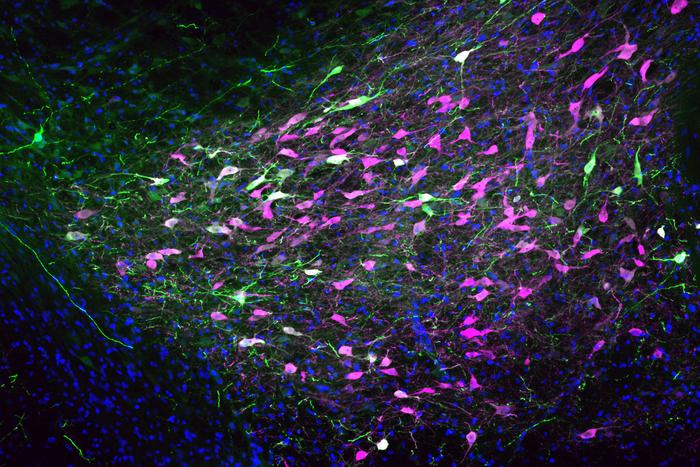The opioid epidemic has tragically taken over half a million lives in the United States since 1999, with a staggering three-quarters of these fatalities occurring among men, as reported by the National Institutes of Health. While the disparity in opioid misuse between genders has been established, the underlying reasons for this phenomenon remain elusive. A groundbreaking new study conducted by researchers at Washington University School of Medicine in St. Louis sheds light on this critical issue, revealing biological differences that could explain why men are more likely than women to abuse opioids and suffer fatal overdoses.
In this intriguing study, researchers observed the behaviors of male and female rats subjected to chronic pain conditions. The findings indicated that male rats, under these circumstances, engaged in escalating doses of the opioid fentanyl, while their female counterparts maintained a stable intake. This behavioral discrepancy, the researchers concluded, was primarily influenced by sex hormones. When male rats were administered estrogen, their fentanyl consumption stabilized, mirroring the patterns seen in female rats. This discovery suggests that hormonal balance significantly impacts opioid behavior and may contribute to the higher rates of opioid misuse among men.
The implications of the study, published in the journal Neuron, are monumental. They suggest that hormonal interactions may dissect the complex relationship between chronic pain, opioid use, and the consequent risk of addiction. According to lead author Jessica Higginbotham, Ph.D., and her team, understanding these hormonal dynamics could unlock new avenues for preventing opioid use disorder, especially in populations afflicted by chronic pain conditions. This perspective represents a shift in focus towards biological and hormonal factors contributing to substance misuse, emphasizing that gender differences are rooted in more than just social or environmental conditions.
An examination of the receptors at play reveals that opioids function by blocking pain signals while simultaneously inciting the release of dopamine in the brain’s pleasure centers. Previous research by the same team demonstrated that pain directly influences dopamine levels, thereby intensifying the euphoric response elicited by opioid use. To delineate the role of pain in opioid-seeking behavior along gender lines, the researchers designed a series of experiments utilizing rats with chronic pain in their paws. Notably, the study’s findings demonstrated that male and female rats experienced similar pain levels. However, males exhibited a tendency to increase their fentanyl consumption over time, while females tended to remain stable in their intake.
Key to understanding this behavior is the dopamine response observed during fentanyl administration. The research indicated that male rats in chronic pain exhibited an increasing dopamine response over the study period, while females maintained a constant dopamine release, regardless of their pain levels. Interestingly, male rats mirrored the female response when they were not in pain. This marked difference suggests that chronic pain exacerbates opioid responses in males, leading them to chase the euphoric effects of the drug rather than merely seeking pain relief.
Further insights emerged regarding the role of sex hormones in shaping behaviors related to opioid use. The experiments revealed that the primary sex hormones sourced from ovaries in females—estrogen, progesterone, and small amounts of testosterone—had a notable impact on opioid-seeking behaviors. Female rats that underwent ovariectomy, which involves the removal of ovaries, displayed behaviors resembling those of male rats, characterized by increased dopamine production and escalating fentanyl intake. Conversely, male rats treated with estrogen exhibited stabilized dopamine responses and moderated opioid-seeking behavior, suggesting a significant protective effect.
The implications of this research extend beyond the laboratory. The findings may help elucidate why older women, experiencing hormonal changes due to menopause, show increased rates of opioid misuse compared to their younger counterparts. This research opens new avenues for exploring how hormone therapy or hormonal balance could serve as an intervention to mitigate opioid dependency, particularly amongst individuals suffering from chronic pain.
Moving forward, researchers aim to investigate how various sex hormones, including testosterone and progesterone, may interact and influence opioid behaviors further. As new generations of treatments emerge, understanding the complex interplay of hormones could lead to innovative strategies aimed at reversing the trend of opioid misuse and fostering safer, more effective pain management approaches for both men and women.
Ultimately, this pivotal research provides a critical perspective on the enduring opioid crisis, shining a light on the biological underpinnings of addiction. This deeper understanding could drive the creation of more personalized treatment approaches and the prevention of opioid use disorder across genders, ultimately leading to healthier and more effective pain management strategies in clinical settings.
By unraveling the ties between hormones, pain, and drug responses, researchers not only pave the way for enhanced treatment modalities but also illuminate the critical need for gender-specific approaches to address the nuanced challenges posed by the opioid epidemic.
In conclusion, as the fight against opioid addiction and overdose continues, studies such as this benchmark research at Washington University serve as vital tools, potentially transforming public health initiatives and offering hope for those struggling with opioid-related issues. With further investigation into hormonal effects and their implications on drug behavior, we stand at the threshold of more effective prevention and treatment strategies that could save lives and bring relief to those enduring chronic pain conditions.
Subject of Research: Animals
Article Title: Estradiol protects against pain-facilitated fentanyl use via suppression of opioid-evoked dopamine activity in males.
News Publication Date: 10-Mar-2025
Web References:
References:
Image Credits: Jessica Higginbotham/WashU Medicine
Keywords: Opioids, Dopamine, Chronic pain, Estrogen, Drug abuse, Gender




